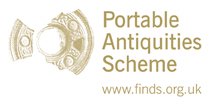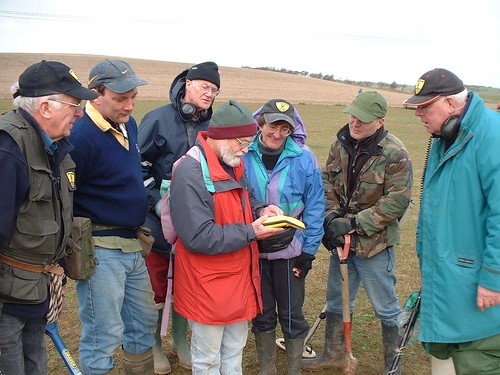Server check!
You are on the training database
Getting involved with the Scheme
Would you like to help add to our knowledge of how people lived in the past through the Portable Antiquities Scheme (PAS)? If so, we would be very happy to hear from you!
You can support our work in two main ways: by reporting any archaeological objects (over 300 years old) you have found, or by volunteering to help record finds.
To report your finds, get in touch with your local Finds Liaison Officer. They will identify and record your finds onto our database for you and others to see and researchers to study.
Help Record Our Past for the Future
Responsible metal-detecting can help us understand the past. Often metal-detected finds will be the only evidence for human activity, but once these have been removed from the ground (unless properly recorded) that evidence is lost. Finders therefore should follow the Code of Practice for Responsible Metal Detecting in England and Wales, and record their finds with the Portable Antiquities Scheme (PAS).
The PAS records finds discovered by the public to advance knowledge of the archaeology of England and Wales. This data is available through its online database. Anyone can access this information, but precise findspot information is only available to legitimate researchers.
The Scheme consists of 40 locally based Finds Liaison Officers (FLOs) covering the whole of England and Wales. Their job is to liaise with finders and record their finds.
FLOs are interested in seeing all archaeological objects and coins that you have found, but need to be selective in what they record. Finds will be borrowed from you, but will be returned once they have been identified and recorded. It is important that you supply a precise National Grid Reference (at least to 6-figures) for all finds, as without a location, they have little archaeological value.
Under the Treasure Act 1996, finders must by law report finds of potential Treasure. It is normally the case that such finds are reported to the relevant FLO, who is able to provide further advice and guidance on the process.
The Act allows a national or local museum to acquire Treasure for public benefit. If this happens a reward is paid, which is normally shared equally between the finder and landowner. Rewards are set at the full market value, determined by the Secretary of State who is advised by an independent panel, the Treasure Valuation Committee. Finders or landowners sometimes do not claim their reward, thereby enabling museums to acquire finds at reduced or no cost.
It is the law that archaeological finds cannot leave the United Kingdom without an export licence: this is required for all finds that are over 50 years old. It is the exporter's obligation to apply for a licence, and it is advised that they use the PAS database reference for all finds in export applications.
The PAS is managed by The British Museum at Portable Antiquities & Treasure, British Museum, London, WC1B 3DG. Tel: 0207 323 8611. Email: info@finds.org.uk.
This information is available in Dutch, English, French, German, Italian, Polish.
PASt Explorers

PASt Explorers was a project funded by the National Lottery Heritage Fund to enhance the PAS's volunteer programme, running from November 2014 until April 2021.
Under PASt Explorers, volunteers became part of a local team with the Finds Liaison Officer, receiving training in identifying and recording archaeological finds onto the PAS database.
PASt Explorers' legacy was to produce resources to support volunteers and an area of the PAS website dedicated to local finds recording, the County Pages.
The Scheme's Logo and Branding
The scheme's full working name is "The Portable Antiquities Scheme", sometimes shortened to PAS.
Our logo incorporates a stylised version of a beautiful example of an Anglo-Saxon brooch from Eastry in Kent.
The story behind the discovery
Whilst filming near Eastry as part of a television programme on metal-detecting called 'Pastfinders', Alan Elliott of the White Cliffs Metal Detecting Club found part of what he at first thought was a piece of Victorian jewellery. On closer inspection, however, it proved to be part of the front plate of an early seventh century Anglo-Saxon plated disc brooch.
The brooch is gold, decorated with gold cells set with garnets and blue glass, and some extremely delicate gold filigree work. Unfortunately, it is very badly damaged, but it would clearly have been a very high-quality piece of jewellery when complete. It was probably made at Faversham, which appears to have been established as a high status craft centre, perhaps under the patronage of the Kentish royal house, in the second quarter of the sixth century.
When the gold brooch fragment was shown to the landowners, they remarked that they had a similar item in their cupboard. This was duly produced and turned out to be two parts of a gilt silver Kentish disc brooch. This had been found by a metal-detectorist on the same field as the gold example, about 15 years previously, and again had been mistaken as Victorian.
Typologically it is slightly earlier in the sequence of high status Kentish jewellery than the plated disc brooch, and was probably manufactured during the last decade of the sixth century, again probably at Faversham.
Logo Kit and Permissions
If you need to reproduce our logo for a document or publication, please contact the PAS Central Unit at info@finds.org.uk. Use of these logos must be cleared with our Central Unit.
Our logos should only be used as an image file. Please do not attempt to reproduce our logo using any fonts other than those supplied as the image.
Our logo comes in print and web formats in a logo kit.
If you right click website logo itself and save a copy, then image quality will not be of high enough resolution for press or print purposes.
Included within this logo kit is a website link image. Alternatively, copy and paste this HTML code reprinted below into your HTML:
<a href="http://www.finds.org.uk" title="Go to the finds website"><img src="http://www.finds.org.uk/images/logos/pasrgbsize5.gif" alt="Portable Antiquities Scheme" width="139" height="68"></a>
This will produce a button as reproduced below:
Test piece
I am having a testing afternoon!
I am editing your testing, Amy




